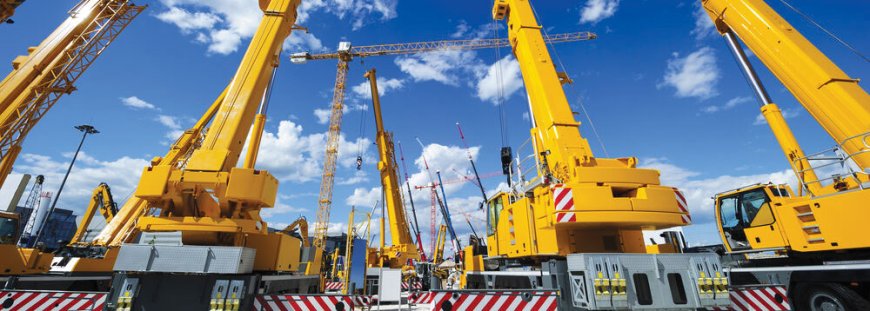Indian rental players in the mobile crane industry typically offer a range of aftermarket services.

Satin Sachdeva, Founder and Secretary General, CERA (Construction Equipment Rental Association), and MD, Equipment Planet
How do you view the current rental market scenario of mobile cranes in India?
Mobile cranes, small pick-and-carry or heavy tonnage hydraulic truck mounted/all-terrain/rough terrain, indeed hold a significant market share in equipment rentals in India due to their versatility and widespread applications in construction, infrastructure development, mining, industrial, metro projects and other relevant sectors. In the current market scenario, with ongoing infrastructure projects and construction activities, the demand for mobile cranes is likely to remain strong due to a major push from the Indian government on infra spending. Pick-and-carry cranes are instrumental in the assembly and disassembly of higher capacity all-terrain and crawler cranes. A key factor contributing to their appeal is competitive pricing, making them an attractive option for potential buyers. This affordability, especially within their designated capacity class, positions them favourably for rental companies and smaller hirers, who form a significant portion of their customer base. Additionally, the trend towards renting equipment instead of purchasing outright continues to drive growth in the rental market, making mobile cranes an attractive option for businesses looking for flexibility and cost-effectiveness. The adoption of precast technology further amplifies the demand for mobile cranes, as they are essential for lifting and positioning precast components efficiently. Moreover, mobile cranes are increasingly required at power plants, refineries, and other relevant projects such as windmill installations, where recent big pushes have necessitated the deployment of significant numbers of crawler cranes, ranging from 600 to 800-ton capacity. This diverse range of applications underscores the robust demand for mobile cranes across various sectors in the current market scenario.
The demand for pick-and-carry cranes is closely tied to industrial growth, as these cranes play a crucial role in various sectors such as infrastructure, mining, industry, and urban infra. Their applications extend to moving small materials, transporting structures, and supporting a range of production activities in manufacturing, industrial and construction sectors.
What are the key challenges in the mobile crane rentals?
The Indian mobile crane rental industry faces several key challenges:
Skilled labour shortage and certification: There is a shortage of skilled operators and technicians in the Indian crane industry. Proper training and certification programs are essential to address this issue and ensure safe and efficient crane operations. There is still a confusion on authentic crane operator certification and regulations.
Unhealthy competition: The Indian mobile crane rental market is competitive, with many local and international players vying for market share. Further price competition can squeeze profit margins, leading to challenges in sustaining business operations.
Economic factors: Fluctuations in the economy, including changes in GDP growth, inflation, and exchange rates, can impact construction activity and, consequently, demand for crane rentals.
Uneven tax structure: The tax structure across different states in India may not be uniform, leading to disparities in tax rates and treatment of goods and services. This non-uniformity can affect the cost of doing business and impact pricing strategies for crane rentals. Companies may need to adjust their pricing models and financial projections to account for variations in tax liabilities across different regions.
Registration of mobile cranes: Registering mobile cranes for interstate operations can be a cumbersome process due to differing registration requirements and procedures in various states. Obtaining permits and approvals for transporting cranes across state borders adds to administrative complexities and may result in delays and additional costs.
Cash flow problems: Delay in payment recoveries is another significant challenge faced by the Indian mobile crane rental industry. Delayed payments can lead to cash flow constraints for crane rental companies, affecting their ability to meet operational expenses such as maintenance, fuel, and payroll. This can disrupt business operations in fleet expansion or technology upgrades. Persistent delays in payment can strain relationships between crane rental companies and their clients. Delayed payment recoveries can impede the growth and expansion plans of crane rental companies. Limited access to working capital may restrict their ability to invest in new equipment, enter into strategic partnerships, or explore market opportunities.
To address these challenges, there is a need for harmonization and simplification of tax regulations across states, as well as streamlined processes for interstate movement and registration of mobile cranes. Government authorities and industry stakeholders can work together to develop standardized procedures. Additionally, advocacy efforts aimed at promoting tax reforms and regulatory consistency can help create a more conducive environment for the mobile crane rental industry in India.
To mitigate the impact of delayed payment recoveries, crane rental companies can implement proactive measures such as:
- Establishing clear payment terms and conditions in standard contracts with clients.
- Conducting thorough credit checks on prospective clients to assess their financial stability and payment history. Proper due diligence is needed
- Implementing robust invoicing and billing processes to expedite payment processing
- Maintaining open communication channels with clients to address any payment-related issues promptly
- Utilizing financial tools such as factoring or invoice discounting to improve cash flow
- Seeking legal recourse or engaging debt collection agencies as a last resort for recovering overdue payments.
Addressing these challenges requires a concerted effort from industry stakeholders, including government agencies, companies, and training institutions, to improve infrastructure, streamline regulations, enhance skill development, and promote innovation in crane technology and operations.
Furthermore, industry associations and regulatory bodies like CERA, COAOI, APAOI, ICEMA, and PHDCCI can play a role in advocating for fair payment practices and enforcing contractual obligations to protect the interests of crane rental companies and promote a more sustainable business environment.

What are the aftermarket services provided by rental players for mobile crane customers?
Indian rental players in the mobile crane industry typically offer a range of aftermarket services to enhance customer satisfaction and ensure the efficient operation of their equipment. Some common aftermarket services provided by Indian crane rental companies include:
Operator training and certification: Rental companies may offer operator training programs to ensure that operators/drivers operate the rented cranes safely and effectively. This training may cover topics such as crane operation, safety protocols, and maintenance procedures.
Maintenance and repair services: Rental companies often offer maintenance and repair services to ensure that their cranes remain in optimal working condition. This may include regular inspections, preventive maintenance, and timely repairs to address mechanical issues and minimize downtime. Many crane rental companies provide round-the-clock support and emergency services to address any operational issues or breakdowns.
Technical consultation: Rental companies often provide technical assistance and consultation services to help customers select the right crane for their specific project requirements. This may include site assessments, load calculations, and recommendations for crane configurations and accessories.
Logistics support: Some rental companies offer transportation and logistics support to facilitate the delivery, set-up, and removal of cranes at customer sites. This may include arranging for specialized transport vehicles, obtaining permits, and coordinating with local authorities.
Spare parts and accessories: Rental companies may stock a range of spare parts and accessories for their crane fleets, allowing customers to quickly obtain replacement components or accessories as needed. This helps minimize downtime and ensures the continued operation of rented cranes.
Customization: Depending on customer requirements, rental companies may offer customization and upgrade services to modify cranes to suit specific project needs. This may involve installing additional features, upgrading components, or retrofitting cranes for specialized applications.
GPS, IOT and Telematics: Some rental companies utilize remote monitoring and telematics systems to track the performance and condition of their crane fleets in real-time. This allows proactive maintenance, early fault detection, and remote diagnostics, improving reliability and reducing downtime. Fuel management is really helpful in tracking diesel thefts and issues related to fuel consumption.
By offering these aftermarket services, Indian rental players aim to differentiate themselves in the competitive market, build long-term relationships with customers, and provide comprehensive support throughout the lifecycle of the rented equipment.
What is your vision on mobile cranes market and how do you see rentals to push the demand for mobile cranes?
My vision for the Indian mobile crane market is one of significant growth and bullish opportunity, driven by various factors such as urbanization, infrastructure development, industrial expansion, and increasing adoption of advanced construction techniques like precast adoption in several elevated projects, metro projects, bullet train projects, etc. As India continues to undergo rapid economic development and urbanization as announced in the recent budget, the demand for mobile cranes is expected to rise exponentially across various sectors including construction, manufacturing, energy, logistics, and transportation.
The rental market will play a crucial role in fuelling this demand for mobile cranes in India. Here's how I see the rental market pushing the demand:
Cost efficiency: Renting eliminates large upfront investments, reduces maintenance costs, and allows for flexible budgeting, benefiting smaller contractors and companies.
Access to advanced technology: Rental companies offer modern crane fleets with the latest technology, enabling businesses to benefit from increased efficiency and safety without ownership burdens.
Scalability and flexibility: Rental market provides businesses with the flexibility to scale crane fleets based on project needs, valuable in dynamic construction environments.
Mitigation of maintenance and operational risks: Renting transfers maintenance and compliance responsibilities to rental companies, helping mitigate risks associated with equipment breakdowns and downtime.
Industry expertise and support: Rental companies provide comprehensive aftermarket services, including operator training and technical support, optimizing crane utilization and improving safety.
Market expansion: Rental options broaden crane access for smaller businesses and contractors, driving overall market growth.
Overall, I envision the rental market as a key driver of demand for mobile cranes in India, providing businesses with cost-effective access to advanced equipment, flexible solutions, and comprehensive support services. As the Indian economy continues to grow and infrastructure investments increase, the rental market's role in meeting the evolving needs of businesses and driving innovation in crane technology and services will become increasingly significant.







